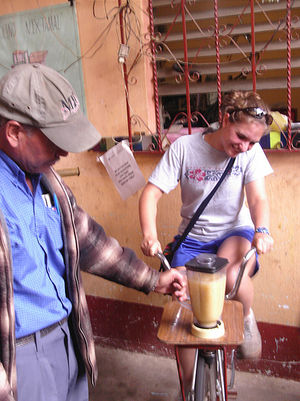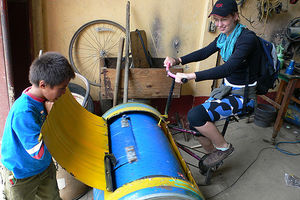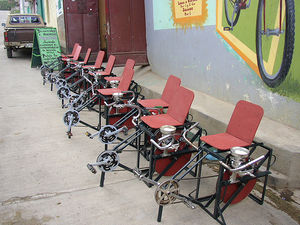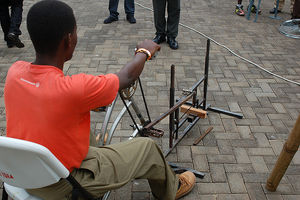Bicycle technology
Bicycle technology ("biketech") is the extension of the basic components of bicycle construction to a larger field of uses. The basic concept of power delivered to pedals (by arms, legs, or other source of motion), transmitted to useful motion by bicycle chains, drive cables, and/or bicycle gears is preserved. The supplied motion however may be used for transportation (people and cargo), water pumping, vacuum pumping, seed winnowing, and so on. Thus, without the infrastructure for electricity or internal combustion, the motive power of human beings can be multiplied and extended to alleviate tedious tasks in agriculture. When all aspects are considered, this technology is probably much less expensive than the current electric way of doing things (build-out for electric infrastructure, mining copper for electric motors, burning fossil hydrocarbons in power plants causing climate disruption etc.).
Set of Components
The set of components utilized in bicycle technology is the simplest set that will enable a human to power a broad range of mechanized devices. This set of components is includes but is not limited to:
- simple gears
- chain links
- crank arms (from pedal to gear)
- bearings
- braided wire (for lever based controls)
- levers (for lever based control)
- pulleys/wheel frames
- drive belts
- metal tubes (welded to make frames)
All of these (except drive belts) are castable or extrudable if a group has metal working technology. However, due to the fact that these parts rarely physically fail and are widely interchangeable, a small casting/extruding operation would likely supply a large population. The commonness of certain larger units, such as forks for holding wheels/pulleys, increases the reusability of parts. Individual devices would require additional components, such as for pumps, blowers, or threshers, which could be manufactured with similar infrastructure.
Maya Pedal
Maya Pedal is a group in Guatemala employing bicycle technology for a large variety of uses amongst agrarian and city folks. The organization has extensive open source downloadable design information on their website.
Applications and Product Ecology
- Examples from Maya Pedal: water (rope) pump, corn grinder, nut sheller, blender, Microconcrete Vibrator for Roofing Tiles, Coffee Depulper, Metal Sharpener, Washing Machine, Electricity Generator (12V), Soil Plow/Till/Hoe, Wood Saw
- Additional examples from "The Human Powered Home": [insert here]
- metallurgy and digital fabrication are needed for manufacture of components
- Compressed air and hydraulic motors as an alternative (or preferred) way to power these devices - is it possible to design a single power interface to use whatever energy is available ??? (i.e. small hydro, wind, biomass, steam engine, human or animal muscle, etc. This would be a big achievement.
Links
- Book by Tamara Dean: "The Human-Powered Home"
- Itech at UC davis offers plans for many useful devices which could be bicycle powered.



